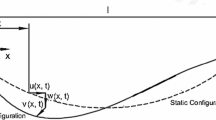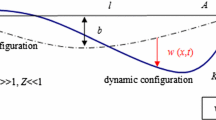Abstract
Cable’s triad and two-to-one mode interactions excited by support motions are modeled and analyzed in a unified boundary modulation formulation. Based upon proper scaling and a boundary resonance concept, the small support motion is modeled as a nonzero boundary modulation term for cable’s reduced (slow) dynamics through attacking cable’s continuous dynamic equations directly by the multiple scale method. Boundary resonance coefficients, characterizing the boundary modulation effect, are derived analytically for both cable’s triad and two-to-one mode resonant dynamics. It is found that the boundary resonance coefficients depend on both cable’s boundary modal information and cable’s initial deformation/sag. Frequency response diagrams based on cable’s reduced models (modulation equations) are obtained, with stability and bifurcation determined. Finally, these approximate analytical results are verified by the numerical results through applying the finite-difference method directly to cable’s original partial differential equations.












Similar content being viewed by others
References
Rega, G.: Nonlinear vibrations of suspended cables, part I: modeling and analysis. Appl. Mech. Rev. 57, 443–478 (2004)
Ibrahim, R.A.: Nonlinear vibrations of suspended cables—part III: random excitation and interaction with fluid flow. Appl. Mech. Rev. 57, 515–549 (2005)
Irvine, H.M., Caughey, T.K.: The linear theory of free vibrations of a suspended cable. Proc. R. Soc. Lond. A 341, 299–315 (1974)
Irvine, H.M.: Cable Structures. The MIT Press, Cambridge (1981)
Triantafyllou, M.S.: Dynamics of cables, towing cables, and mooring systems. Shock Vib. Dig. 23, 3–8 (1991)
Hagedon, P., Schäfer, B.: On non-linear free vibrations of an elastic cables. Int. J. Non-Linear Mech. 15, 333–339 (1980)
Luongo, A., Rega, G., Vestroni, F.: Planar non-linear free vibrations of an elastic cable. Int. J. Non-Linear Mech. 19, 39–52 (1984)
Benedettini, F., Rega, G.: Non-linear dynamics of an elastic cable under planar excitation. Int. J. Non-Linear Mech. 22, 497–509 (1987)
Benedettin, Fi, Rega, G., Vestroni, F.: Modal coupling in the free nonplanar finite motion of an elastic cable. Meccanica 21, 38–46 (1986)
Rao, G.V., Iyengar, R.N.: Internal resonance and non-linear response of a cable under periodic excitation. J. Sound Vib. 149, 25–41 (1991)
Perkins, N.C.: Modal interactions in the non-linear response of elastic cables under parametric/external excitation. Int. J. Non-Linear Mech. 27, 233–250 (1992)
Lee, C.L., Perkins, N.C.: Non-linear oscillations of suspended cables containing a two-to-one internal resonance. Nonlinear Dyn. 3, 465–490 (1993)
Srinil, N., Rega, G., Chucheepsakul, S.: Two-to-one resonant multi-modal dynamics of horizontal/inclined cables. Part I: theoretical formulation and model validation. Nonlinear Dyn. 48, 231–252 (2007)
Pakdemirli, M., Nayfeh, S.A., Nayfeh, A.H.: Analysis of one-to-one autoparametric resonances in cables: discretization versus direct treatment. Nonlinear Dyn. 8, 65–83 (1995)
Lacarbonara, W., Rega, G., Nayfeh, A.H.: Resonant non-linear normal modes. Part I: analytical treatment for structural one dimensional systems. Int. J. Non-Linear Mech. 38, 851–871 (2003)
Lacarbonara, W., Rega, G.: Resonat non-linear normal modes. Part II: activation/orthogonality conditions for shallow structural systems. Int. J. Non-Linear Mech. 38, 873–887 (2003)
Zhao, Y.Y., Wang, L.H.: On the symmetric modal interaction of the suspended cable: three-to-one internal resonance. J. Sound Vib. 294, 1073–1093 (2006)
Nayfeh, A.H.: Non-linear Interactions. Wiley-Inter Science, New York (2000)
Luongo, A., Zulli, D.: Dynamic instability of inclined cables under combined wind flow and support motion. Nonlinear Dyn. 67, 71–87 (2012)
Rega, G., Luongo, A.: Natural vibrations of suspended cables with flexible supports. Comput. Struct. 12, 65–75 (1980)
Rega, G., Alaggio, R.: Spatio-temporal dimensionality in the overall complex dynamics of an experimental cable/mass system. Int. J. Solids Struct. 38(10), 2049–2068 (2001)
Koh, C.G., Rong, Y.: Dynamic analysis of large displacement cable motion with experimental verification. J. Sound Vib. 272(1), 187–206 (2004)
Berlioz, A., Lamarque, C.H.: Nonlinear vibrations of an inclined cable. ASME J. Vib. Acoust. 127, 315–323 (2005)
Rega, G., Alaggio, R.: Experimental unfolding of the nonlinear dynamics of a cable-mass suspended system around a divergence-Hopf bifurcation. J. Sound Vib. 322(3), 581–611 (2009)
Benedettini, F., Rega, G., Alaggio, R.: Non-linear oscillations of a four-degree-of-freedom model of a suspended cable under multiple internal resonance conditions. J. Sound Vib. 182, 775–798 (1995)
Cai, Y., Chen, S.S.: Dynamics of elastic cable under parametric and external resonances. J. Eng. Mech. 120, 1786–1802 (1993)
Lilien, J.L., PintodaCosta, A.: Vibration amplitudes caused by parametric excitation of cable stayed structure. J. Sound Vib. 174, 69–90 (1994)
Pintoda Costa, A., Martins, J.A., Branco, F., Lilien, J.L.: Oscillations of bridge stay cables induced by periodic motions of deck and/or towers. J. Eng. Mech 122, 613–622 (1996)
Berlioz, A., Lamarque, C.H.: A non-linear model for the dynamics of an inclined cable. J. Sound Vib. 279, 619–639 (2005)
Georgakis, C.T., Taylor, C.A.: Nonlinear dynamics of cable stays. Part 1: sinusoidal cable support excitation. J. Sound Vib. 281, 537–564 (2005)
Wang, L.H., Zhao, Y.Y.: Large amplitude motion mechanism and non-planar vibration character of stay cables subject to the support motions. J. Sound Vib. 327, 121–133 (2009)
Gonzalez-Buelga, A., Neild, S.A., Wagg, D.J., Macdonald, J.H.G.: Modal stability of inclined cables subjected to vertical support excitation. J. Sound Vib. 318, 565–579 (2008)
Macdonald, J.H.G., Dietz, M.S., Neild, S.A., Gonzalez-Buelga, A., Crewe, A.J., Wagg, D.J.: Generalized modal stability of inclined cables subjected to support excitations. J. Sound Vib. 329, 4515–4533 (2010)
Kang, H.J., Zhao, Y.Y., Zhu, H.P.: In-plane non-linear dynamics of the stay cables. Nonlinear Dyn. 73, 1385–1398 (2013)
Warnitchai, P., Fujinob, Y., Susumpowc, T.: A non-linear dynamic model for cables and its application to cable-structure system. J. Sound Vib. 187, 695–712 (1995)
Rega, G., Lacarbonara, W., Nayfeh, A.H., Chin, C.M.: Multiple resonances in suspended cables: direct versus reduced-order models. Int. J. Non-Linear Mech. 34, 901–924 (1999)
Lacarbonara, W.: Direct treatment and discretizations of non-linear spatially continuous systems. J. Sound Vib. 221, 849–866 (1999)
Nayfeh, A.H., Arafat, A.H., Chin, C.M., Lacarbonara, W.: Multimode interactions in suspended cables. J. Vib. Control 8, 337–387 (2002)
Shaw, S.W., Pierre, C.: Normal modes of vibration for non-linear continuous systems. J. Sound Vib. 169, 319–347 (1994)
Gattulli, V., Lepidi, M.: Localization and veering in cable-stayed bridge dynamics. Comput. Struct. 85(21–22), 1661–1668 (2007)
Nayfeh, A.H., Balachandran, B.: Applied Nonlinear Dynamics. Wiley-Interscience, New York (1994)
Ermentrout, B.: Simulating, Analyzing, and Animating Dynamical Systems–A Guide to XPP-AUTO for Researchers and Students. SIAM, Philadelphia (2002)
Srinil, N., Rega, G.: Space-time numerical simulation and validation of analytical predictions for nonlinear forced dynamics of suspended cables. J. Sound Vib. 315, 394–413 (2008)
Acknowledgments
This study is funded by Program for Supporting Young Investigator, Hunan University. And it is also supported by National Science Foundation of China under Grant Nos. 11502076 and 11572117. Interesting comments and criticism by the reviewers are also gratefully acknowledged.
Author information
Authors and Affiliations
Corresponding author
Appendices
Appendix 1
Suspended cable’s linear modal analysis can be found in reference [3]. We restrict our attention to cable’s in-plane symmetric modes in this paper, and these modes are given by
where \(c_{i}\) is the normalization constants. And the associated eigenfrequencies are determined by
where \(\lambda ^{2}=EA/mgl(8b/l)^{3}\) is the elasto-geometric parameter. The above nonlinear transcendental equations can be solved by the Newton–Raphson method.
Appendix 2
Appendix 3
Single-mode solutions associated with triad mode resonance and two-to-one resonance, and their stability analysis, are determined by following reference [18].
The single-mode equilibrium solutions of cable’s modulation equations are obtained through setting \(a_1 =a_2 ={a}_3' ={\gamma }_2' =0\) in Eqs. (44)–(46) and Eqs. (47) and (48)
For coupled-mode solutions, the cable’s high-frequency mode \(a_{3}\) is saturated at (i.e., keeping constant if arriving at a critical value, irrespective of the excitation)
In other words, \(0\le a_3 \le a_3^*\). Furthermore, the single-mode equilibrium solution in Eq. (67) is stable if \(a_3 <a_3^*\), otherwise unstable.
Rights and permissions
About this article
Cite this article
Guo, T., Kang, H., Wang, L. et al. Cable’s mode interactions under vertical support motions: boundary resonant modulation. Nonlinear Dyn 84, 1259–1279 (2016). https://doi.org/10.1007/s11071-015-2565-4
Received:
Accepted:
Published:
Issue Date:
DOI: https://doi.org/10.1007/s11071-015-2565-4




